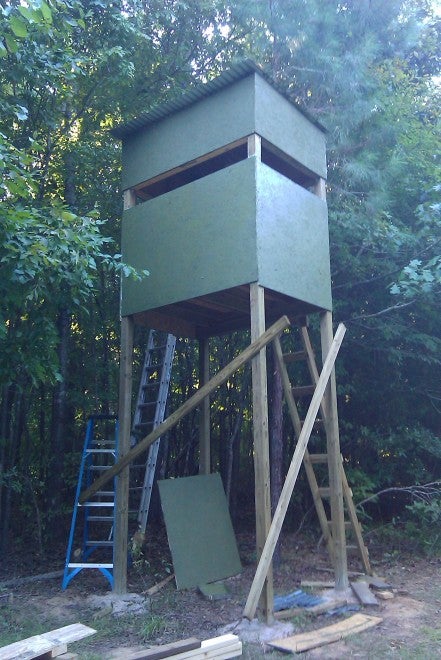Pros and cons of fixed deer stands
Dr. John Woods 09.09.13

Big time in vogue these days among deer hunters are hunting stands curiously referred to as “shooting houses.” In some cases they nearly are as fancy as a small scale house, but most often they are just a plywood box with roof, door, and windows. In time, other amenities are added to make them a bit cozier.
There are commercially manufactured shooting houses on the market costing thousands of dollars, including some mounted on wheeled trailers for mobility. You tend to see a lot of these really custom jobs in deer hunting fields in Texas.
Either way, the bottom line is, do such stands actually enhance the potential of hunting success? What are the advantages and disadvantages of placing a permanent shooting house or any other hunting stand in one place?
In the short term, deer will take notice of anything new. It could be something as conspicuous as a shooting house appearing virtually overnight, or something temporary like parking an ATV where deer can see it. They will steer clear of these things for a while until they grow used to it. This is reason enough for putting any permanent stand up as early in the year as possible so deer have time to become accustomed to it.
Then there is the issue of the coming and going to the stand without being obviously detected. Deer are going to pattern these movements like the hands on a clock. It will continue to be one of the high risk factors in setting up permanent stands in fixed locations.
However, the movement factor can be overcome by a judicious use of common sense. Hunters must always approach their stands when the wind is blowing in their favor. To do otherwise is just to advertise your presence. Deer may get over that in a while, if you have the time to wait them out. It is more likely that trophy class bucks would be far less forgiving.
Permanent deer stands are usually put up in good places to hunt. A stand might be nestled into the corner of a food plot to offer an wide angle view of a prime spot where bucks come to feed or to chase a doe. It could be in the crosswalk of two or more trails where deer frequently travel. Hiding out in the middle of a big section of woods with a 360 degree point of view can be a good vantage point as well.
Shooting houses tend to be comfortable with protection from the elements. Cold? Just crank up the propane heater. Raining? Just close down the clear window to keep moisture out but continue watching for deer. Lean back in that fold-out cushion chair or padded office seat that you put in the shooting house. Lay all your gear out on the wall shelves in the house, and prop your deer rifle in the corner. Prop up your elbows and glass the area with your binoculars while you relax in style. Just don’t fall asleep and miss a shot.
Sounds a bit over the top doesn’t it. The thing is, though, if you can hunt in relative comfort then you are more likely to stay out longer and put more time into the hunt. More often than not, the time on task factor is a major contributor to hunting success. A permanently located shooting house or other stand can solve the comfort issue.
Dovetailing on this comfort factor is the opportunity to expose young hunters to hunting without also exposing them to the severe elements Mother Nature can dish out. It will increase the fun and quality family factor to have mom and kids along on your deer hunts, or it offer an opportunity for a son or daughter to spend time with dad or mom.
Permanent stands can be camouflaged or allowed to be partially covered by natural growth to help hide them. At our hunting club every year we have to clear out the vines and leafy growth that completely engulfs our permanent stands. From a distance, the shooting houses look like one big bush. We clean them out, climb in and hunt. It’s perfect.